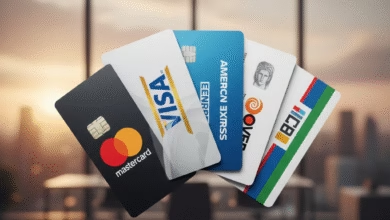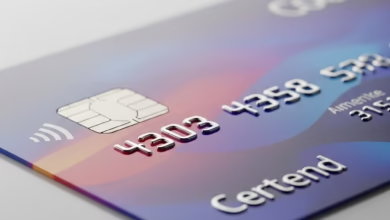How to rebuild credit after defaulting on a credit card
Learn how to rebuild your credit card after defaulting on a payment

It’s a feeling that sinks deep into your stomach: the realization that a credit card bill has slipped past its due date. At first, it might be 30 days late. Then 60. Then 90. Before you know it, your account is “delinquent,” your credit score has plummeted, and you’re getting nonstop calls from collectors.
If this sounds familiar, take a deep breath. You are not the first person to go through this, and you absolutely will not be the last. A financial setback, a medical emergency, a job loss, or even a simple mistake can lead to credit card delinquency.
The good news? It is 100% fixable.
Rebuilding your credit after a delinquency isn’t a quick sprint; it’s a marathon. It requires a plan, patience, and a new set of financial habits. But with the right strategy, you can—and will—reclaim your financial health. This guide is your step-by-step roadmap.
First, Understand the Damage: What Is Credit Card Delinquency?

“Delinquency” isn’t a single event. It’s a “waterfall” of escalating seriousness. Understanding these stages is key to understanding what’s on your credit report.
- 30 Days Past Due: Your payment is officially late. Your card issuer will charge you a late fee and (likely) a penalty APR. They will report this 30-day late payment to the three credit bureaus.
- 60 Days Past Due: You have now missed two consecutive payments. This is another, more serious, negative mark on your credit report.
- 90 Days Past Due: This is a major red flag for lenders. A 90-day delinquency is significantly more damaging to your FICO score than a 30-day one.
- 120-150 Days Past Due: At this point, the original creditor is losing hope of payment and is preparing to “charge off” the account.
- 180 Days Past Due (The “Charge-Off”): This is the final stage. The original creditor (like Visa or Capital One) gives up, writes the debt off as a loss on their books, and closes your account.
This is the most misunderstood part: A “charge-off” does NOT mean your debt is forgiven. It simply means the original creditor has sold your debt, usually for pennies on the dollar, to a third-party collection agency.
You now owe the money to the collection agency, and your credit report shows a “charge-off,” one of the most severe negative items you can have.
Why a Single Late Payment Can Devastate Your FICO Score
To fix your score, you have to know what’s in it. Your FICO score—the three-digit number lenders use to judge your creditworthiness—is made of five pieces. Look at the biggest one.
- Payment History (35%): This is the single biggest chunk of your score. A delinquency is a direct hit to this category, which is why your score drops so fast.
- Amounts Owed (30%): This includes your credit utilization (how “maxed out” your cards are).
- Length of Credit History (15%): The average age of your accounts.
- New Credit (10%): How many new accounts you’ve recently applied for.
- Credit Mix (10%): Having a healthy mix of accounts (like a credit card and an auto loan).
When you have a delinquency, you’re damaging the most important part of your score. The goal of “rebuilding” is to repair that 35% slice by burying the old, negative information with a new, overwhelming amount of positive information.
Your 7-Year Rebuilding Plan: A Step-by-Step Framework
Here’s the hard truth: that delinquency, charge-off, or collection will stay on your credit report for seven years from the “Date of First Delinquency” (DPOF)—the date your account first became late and never recovered.
You cannot change the past. But you can change the present and the future. Starting now.
Step 1: Conduct a Full Credit Audit (Know Where You Stand)
You cannot fix a problem you don’t fully understand. Before you pay anyone or apply for anything, you must become an expert on your own credit file.
- Pull Your Reports: Go to AnnualCreditReport.com. This is the only official, federally-mandated website to get your full, free credit reports from all three bureaus (Experian, Equifax, and TransUnion) once per year.
- Analyze the Damage: Print them out and go through them with a highlighter. For every delinquent account, identify:
- Who is the original creditor?
- What is the “Date of First Delinquency”?
- Is the account status “Charged-Off” or “In Collections”?
- Who owns the debt now? (e.g., “XYZ Collection Agency”).
- What is the exact balance owed?
- Check for Errors: Is the balance wrong? Is an account listed that isn’t yours? Is a late payment listed by mistake? Make a note of any potential errors to dispute later.
You now have your “battle map.” You know exactly what you’re up against.
Step 2: Stop the Bleeding (Get Current and Stay Current)
This is the most critical, non-negotiable step. You cannot rebuild your credit if you are still in delinquency.
If you have other accounts that are also late, you must get them current immediately. If you’re struggling to make ends meet, this is where you have to get serious about your budget.
- Create a Zero-Based Budget: Every single dollar of income is assigned a job (rent, utilities, food, debt).
- Cut Expenses: This is temporary. Cut streaming services, dining out, and any non-essential spending.
- Pause Credit Card Use: Take the cards out of your wallet. You cannot add new, positive history while you are still digging a deeper hole.
Your primary goal is to stop new 30-day late payments from ever happening again.
Step 3: Strategically Address Old Debts (Collections & Charge-Offs)
Now you look at your “battle map” from Step 1. You have old, charged-off accounts sitting there. You have three main options for dealing with them.
Important Note: Newer FICO score models (FICO 9, 10, and 10T) are more forgiving of paid collections. A collection with a $0 balance looks much, much better to a lender than an open, unpaid one. Paying this debt, even though it won’t remove the charge-off history, is a powerful step in rebuilding.
Option 1: Pay in Full
You contact the collection agency, verify the debt, and pay the full original amount. The account status on your credit report will be updated to “Paid in Full” or “Paid Collection.” This is the best possible outcome for a collection account.
Option 2: Settle for Less
Collection agencies bought your debt for pennies. They are often willing to “settle” for less than the full amount (e.g., 40-60% of the balance).
- Pro: You save money and the debt is closed.
- Con: The account status will be updated to “Settled for Less Than Full Amount.” This is still good (it’s paid!), but it’s not quite as strong as “Paid in Full.”
- How to do it: Get the settlement offer in writing before you pay a single cent.
Option 3: The “Pay-for-Delete” (The Holy Grail)
This is a negotiation. You contact the collection agency and offer to pay (either in full or a settlement) in exchange for their agreement to delete the entire account tradeline from your credit report.
- This is the best possible outcome, as it removes the negative item entirely.
- It is becoming less common, as agencies are contractually obligated to report accurately.
- If you attempt this, GET THE AGREEMENT IN WRITING before you pay. A verbal promise is worthless.
What about the “Statute of Limitations”? The SOL is the time limit a collector has to sue you for a debt. This does not remove the debt from your credit report. The 7-year reporting rule is separate. Paying an old debt can sometimes restart the SOL, so be sure to check your state’s laws if the debt is very old.
Step 4: Add New, Positive Credit (The “Rebuilding” Phase)
This is where the real rebuilding begins. Your FICO score is a “snapshot” of your recent behavior. You need to give it new, positive data to look at. You need to prove you can be trusted with credit today.
How do you get credit when your credit is bad? You use specific tools designed for this exact purpose.
Tool #1: The Secured Credit Card (Your Most Powerful Ally)
This is the #1 tool for rebuilding credit. It is not a debit card or a prepaid card. It is a real credit card that reports to all three credit bureaus.
How it works:
- You Pay a Deposit: You give the bank a refundable cash deposit, typically $200.
- Your Deposit = Your Limit: That $200 deposit becomes your credit limit.
- You Use It Normally: You use the card for a small, regular purchase (like your Netflix bill or a tank of gas).
- You Pay the Bill: You get a monthly statement, and you pay it in full from your checking account. (Your deposit is not used to pay the bill; it’s just held as collateral).
- You Build History: The bank reports your on-time payment to Equifax, Experian, and TransUnion.
You have now added a brand new, 100% positive payment history to your credit report. This is the antidote to your old delinquency. After 6-12 months of perfect payments, your score will climb, and the bank will often “graduate” you to an unsecured card and refund your deposit.
Tool #2: The Credit-Builder Loan (Prove Your Repayment)
This is another fantastic tool, often offered by local credit unions. It’s like a loan in reverse.
How it works:
- You “Borrow” Money: A bank “lends” you $500 or $1,000, but they don’t give you the cash. They put it in a locked certificate of deposit (CD) or savings account in your name.
- You Make Payments: You make small, fixed monthly payments (e.g., $42/month for 12 months) into that account.
- You Build History: Each of those 12 payments is reported to the credit bureaus as an on-time installment loan payment. This builds your “Credit Mix” (10% of your score).
- You Get Your Money: At the end of the 12-month term, the bank “unlocks” the account, and you get the full $500 or $1,000, plus any interest it earned.
You’ve built a full year of perfect payment history on an installment loan, and you’re forced to save money in the process.
Tool #3: Becoming an Authorized User (Piggybacking for a Boost)
If you have a trusted family member or partner with a long, perfect credit history, you can ask them to add you as an “Authorized User” (AU) on their card.
- The Pro: You “inherit” the history of their account. If your mom adds you to her 20-year-old Amex card that has a low balance and perfect payment history, your FICO score can get a significant boost, and it helps lower your overall “credit utilization.”
- The Con: It’s a relationship based on trust. You also inherit their bad habits. If they max out the card or miss a payment, it will hurt your credit, too. (Note: You are not legally responsible for the debt, but it will show up on your report).
Step 5: Master Credit Fundamentals to Make Your New Score Stick
Getting the new tools is only half the battle. Using them correctly is what builds the score.
Rule 1: Pay On Time, Every Time (The 35% Factor)
This is the new golden rule of your life. Set up autopay for at least the minimum on your new secured card. A single late payment at this stage would be catastrophic.
Rule 2: Master Your Credit Utilization (The 30% Factor)
This is the “fast lane” to a better score. Your utilization is how much of your limit you’re using.
- Bad: $250 balance on your $300 secured card = 83% utilization (HIGH RISK)
- Good: $30 balance on your $300 secured card = 10% utilization (LOW RISK)
Pro-Tip: Don’t just stay under 30%. For the fastest score boost, keep your reported balance under 10%. You can do this by using the card for a $15 Netflix sub, and then paying it off in full a few days before your statement closes.
Beyond the Basics: Advanced Tactics for Credit Recovery

Once you have your new habits in place, you can try these advanced strategies.
1. The “Goodwill Letter”
This is for the original delinquency, especially if it was a one-time mistake. You write a polite, professional letter to the original creditor (not the collection agency) asking for a “goodwill adjustment.”
You explain what happened (e.g., “I was in the hospital,” “I lost my job and got overwhelmed”) and show proof of your new, positive habits (e.g., “As you can see, I’ve had 12 straight on-time payments since then”). You then ask (don’t demand) if they would be willing to remove the late payment marks from your report as a gesture of goodwill.
It’s a long shot, but it has zero cost and can have a huge reward.
2. Disputing Fact-Based Errors
From your Step 1 audit, if you found legitimate errors (e.g., they listed the balance as $2,000 but it was only $1,000, or the account isn’t yours), you must dispute them. You can do this for free on the Experian, Equifax, and TransUnion websites. By law, they must investigate and remove verifiably false information.
What About “Credit Repair” Companies? A Word of Warning
You will see ads for companies that promise to “fix your credit fast” or “remove all negative items.” Be extremely careful.
- The Scams: Many charge high upfront fees (which is illegal), promise “guaranteed” results, or tell you to lie. Run away.
- The Legitimate Help: Reputable, non-profit credit counseling agencies (like those affiliated with the NFCC, or National Foundation for Credit Counseling) are different. They won’t “fix” your credit. They will sit down with you, help you create a real budget, and can set you up with a Debt Management Plan (DMP), which consolidates your debts into one payment at a lower interest rate.
You don’t need to pay a “credit repair” company $100 a month to do what you can do yourself with this guide.
How Long Will It Take? Setting Realistic Expectations

- First 6 Months: You’ll see the first “green shoots” of recovery. You’ll have a new secured card and a 6-month history of perfect payments. Your score will start to tick up.
- First 1-2 Years: This is where you’ll see significant progress. You may have “graduated” to an unsecured card, your utilization will be low, and the new, positive data will start to outweigh the old negative marks.
- Years 2-7: Your score continues to climb as you maintain perfect habits.
- Year 7: The original delinquency or charge-off will fall off your report entirely. Your score will often see its final, significant jump. You are fully recovered.
Your Delinquency Doesn’t Define You
A credit card delinquency feels like a permanent stain, but it’s not. It’s a temporary problem that can be solved with a permanent solution: consistency.
Your credit report tells a story. Right now, it might be telling a story of a difficult time. By following these steps, you are taking control of the narrative. You are burying that old chapter with a new, better story of on-time payments, low balances, and financial responsibility. That is the story that will build your future.





